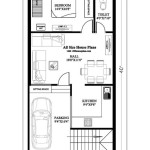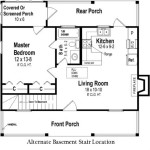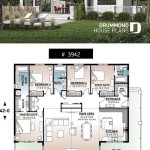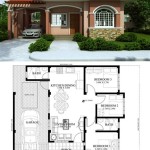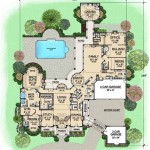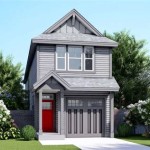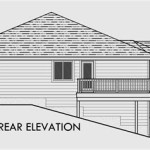House Plans With Mother-In-Law Quarters: A Comprehensive Guide
The rise in multigenerational living has fueled the demand for house plans incorporating mother-in-law quarters, also known as in-law suites, accessory dwelling units (ADUs), or secondary suites. These living spaces are designed to provide independent living areas within a single-family home, accommodating family members, caregivers, or even renters. These plans offer a balance of privacy and togetherness, addressing the needs of aging parents, adult children returning home, or those seeking to offset mortgage costs.
When considering house plans with mother-in-law quarters, it's crucial to understand the various design options available and the benefits each offers. Choosing the right plan involves careful consideration of family needs, budget constraints, and local zoning regulations. This article will delve into the key aspects of these house plans, providing valuable insights to assist in making informed decisions.
Understanding the Benefits of Mother-In-Law Quarters
Integrating a mother-in-law suite into a home's design presents numerous advantages. Primarily, it fosters closer family relationships while maintaining a degree of independence for all parties involved. Aging parents can reside nearby, allowing for easy access and care, while still enjoying their own private space. This proximity can alleviate concerns about elder care and provide peace of mind for both generations.
Financially, mother-in-law suites can offer significant benefits. They can provide rental income, helping to offset mortgage payments and other living expenses. This is particularly attractive in areas with high housing costs. Alternatively, the space can accommodate adult children as they navigate career transitions or save for their own homes. The flexibility afforded by these suites ensures that the home remains adaptable to changing family circumstances.
Beyond family and financial advantages, mother-in-law suites can enhance the overall value and appeal of a home. A well-designed suite with its own entrance, bathroom, and kitchen adds to the property's desirability, making it more attractive to potential buyers in the future. The increased functionality and versatility of the home position it as a valuable asset in a competitive real estate market.
Key Design Considerations for In-Law Suites
Designing a functional and comfortable in-law suite requires careful planning and attention to detail. Several factors must be considered to ensure the space meets the specific needs of its occupants. These factors include accessibility, privacy, functionality, and aesthetic integration with the existing home.
Accessibility is paramount, particularly if the suite is intended for elderly or disabled individuals. Features such as wider doorways, grab bars in bathrooms, and ramps or elevators can significantly improve ease of movement and safety. Single-story layouts or ground-floor access are also highly desirable. Universal design principles should be incorporated to create a space that is usable by people of all ages and abilities.
Privacy is another crucial consideration. While the goal is to foster proximity, it's equally important to ensure that both the main house and the suite have separate entrances and living areas. Soundproofing measures, such as insulation and solid-core doors, can minimize noise transmission and enhance privacy. Thoughtful placement of windows and doors can also control views and create distinct living spaces.
Functionality is vital for creating a comfortable and self-sufficient living space. The suite should include a fully equipped kitchen or kitchenette, a private bathroom, a living area, and a bedroom. Ample storage space is also essential. The layout should be designed to maximize usable space and minimize clutter. The size and configuration of the suite should be tailored to the specific needs and preferences of its occupants.
Finally, the suite should be aesthetically integrated with the existing home. The style, materials, and finishes should complement the overall design of the house. This creates a cohesive and harmonious look, enhancing the property's overall appeal. Attention to detail, such as coordinating paint colors and flooring, can create a sense of unity and flow between the main house and the suite.
Types of House Plans with Mother-In-Law Quarters
House plans with mother-in-law quarters come in various configurations, each offering distinct advantages depending on the homeowner's needs and the property's spatial characteristics. These plans can be generally categorized into attached suites, detached suites, and internal adaptations.
Attached suites are the most common type of mother-in-law quarters. These suites are connected to the main house but have their own separate entrance, living area, kitchen, bathroom, and bedroom. They can be integrated into the existing house during construction or added as an extension. Attached suites offer the convenience of easy access to the main house while still maintaining a degree of privacy and independence.
Detached suites, also known as accessory dwelling units (ADUs), are separate structures located on the same property as the main house. These can range from small cottages to converted garages or backyard apartments. Detached suites offer the highest level of privacy and independence. They require careful planning to ensure compliance with local zoning regulations and building codes. Access to utilities, such as water, sewer, and electricity, must also be considered.
Internal adaptations involve modifying existing spaces within the main house to create a self-contained suite. This might involve converting a basement, attic, or spare bedroom into a living area with its own kitchenette and bathroom. Internal adaptations are a cost-effective way to create a mother-in-law suite without the expense of adding a new structure. However, they may require significant renovations and may not offer the same level of privacy as attached or detached suites.
The choice of which type of plan to implement will depend on several factors. Lot size, zoning regulations, budget, and the desired level of independence for the suite's occupants are all considerations that should be taken into account during the planning process.
Navigating Zoning Regulations and Building Codes
Prior to embarking on any construction project, it's imperative to thoroughly research and understand local zoning regulations and building codes. These regulations govern the size, location, and design of mother-in-law suites and can significantly impact the feasibility and cost of the project. Failure to comply with these regulations can result in costly delays, fines, or even the removal of the suite.
Zoning regulations typically address issues such as minimum lot size, setbacks from property lines, height restrictions, and parking requirements. Additionally, some jurisdictions may have specific restrictions on the size and occupancy of accessory dwelling units. It's essential to consult with the local planning department or a qualified land use attorney to ensure that the proposed suite complies with all applicable zoning regulations.
Building codes regulate the structural integrity, safety, and energy efficiency of buildings. They cover aspects such as foundation requirements, framing, electrical wiring, plumbing, and insulation. Building permits are typically required for any construction project that involves structural changes or significant alterations to existing systems. It's important to hire licensed and insured contractors who are familiar with local building codes and can ensure that the suite is built to meet all applicable safety standards.
In addition to zoning regulations and building codes, homeowners should also be aware of any homeowners association (HOA) rules that may apply. HOAs often have restrictions on the type of construction that is allowed within the community, as well as rules regarding the appearance and use of accessory dwelling units. Reviewing the HOA's covenants, conditions, and restrictions (CC&Rs) is essential to ensure compliance and avoid potential conflicts.
Cost Considerations for Building an In-Law Suite
The cost of building a mother-in-law suite can vary widely depending on several factors, including the size and complexity of the project, the type of suite (attached, detached, or internal adaptation), the quality of materials used, and the location of the property. It's crucial to develop a realistic budget that takes into account all potential costs, including design fees, permits, materials, labor, and landscaping.
Attached suites are generally less expensive to build than detached suites, as they share a common wall and utilities with the main house. Internal adaptations are typically the most cost-effective option, as they involve modifying existing spaces rather than constructing new ones. However, the extent of the renovations required can significantly impact the overall cost.
The cost of materials can also vary widely depending on the quality and type of materials used. High-end finishes, such as granite countertops, hardwood floors, and custom cabinetry, will significantly increase the cost of the project. Choosing more affordable materials, such as laminate countertops and vinyl flooring, can help to keep the budget in check.
Labor costs are another significant factor to consider. Hiring licensed and insured contractors is essential to ensure that the suite is built to meet all applicable building codes and safety standards. However, skilled tradespeople typically command higher wages. Obtaining multiple bids from different contractors can help to ensure that you are getting a fair price for the work. Consider soliciting quotes from general contractors who specialize in ADU builds, as their expertise may streamline the process and potentially reduce costs.
It's also important to factor in the cost of permits and design fees. Building permits can range from a few hundred dollars to several thousand dollars, depending on the size and complexity of the project. Design fees can also add a significant cost, particularly if you hire an architect or designer to create custom plans. Budgeting for these costs upfront can help to avoid unexpected surprises down the road.
Finally, consider the long-term costs of operating and maintaining the suite. These costs might include utility bills, property taxes, and insurance premiums. Factoring in these costs into your overall budget can help you to make informed decisions about the size and features of the suite.
By carefully considering all of these factors, you can develop a realistic budget for building a mother-in-law suite that meets your needs and fits your financial resources.

Plan 65862 Tuscan Style House Floor Plans With 2091 Sq Ft 3 Be

In Law Suite Plans Give Mom Space And Keep Yours The House Designers

Image Result For Home Plans With Courtyard And Mother In Law Suite House New One Story

Homes With Mother In Law Suites

Mother In Law Suite Floor Plans Basement House

Craftsman House Plan With In Law Suite 1443

6 Bedroom Country Style Home With In Law Suite The Plan Collection
:max_bytes(150000):strip_icc()/bellewood-cottage-2c59d5ea867a4fe196ff5a9ad12c6812.jpg?strip=all)
House Plans With Mother In Law Suites

Better Mother In Law Suite Multigenerational House Plans One Story Mediterranean Style

Traditional Home With Mother In Law Suite 35428gh Architectural Designs House Plans

